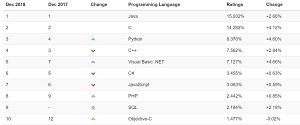News
Popularity Index Charts Rise of VB.NET
- By David Ramel
- December 17, 2018
Microsoft's oft-maligned Visual Basic .NET programming language was the big mover in the December TIOBE Programming Community index, which gauges programming language popularity.
In fact, VB.NET was the focal point of TIOBE's blog post for this month's report, which sees the language reach No. 5, an all-time high.
The company seemed to express some of the same negative perceptions of the language that have marked its evolution, even asserting it's a "toy" language meant for beginners and predicting a future decline:
Microsoft's Visual Basic .NET is currently at position 5 of the TIOBE index with an all time high. This is very surprising. Professional software developers don't think much of Visual Basic. It is considered a toy language meant for people who start to learn programming. This is true, but it can't be denied that there are many programs and applications written in Visual Basic, also in the professional domain. Many dedicated office applications for small and medium enterprises have been developed with this programming language because of its rapid prototyping and because it is easy to pick up. Microsoft is slowly saying goodbye to Visual Basic by stopping the co-evolution strategy with C#. So I think the current popularity of Visual Basic will sooner or later go into decline again.
Nevertheless, legions of devotees -- and a rabid following who still cry for a revival of "classic" VB -- still support and use the language.
That includes sister publication Visual Studio Magazine's own Peter Vogel, who often uses it in his popular how-to tutorials on .NET development.
Recently, when asked by a reader, "Why in the world are you using VB.NET?" Vogel replied: "Why not? It's a perfectly good language. I like it about as much as C# and I think it's easier for people to read even if they don't know it (compared to, for example, C# or JavaScript)."
Many other pros use it too, under a wide range of circumstances, including Bob Hosea, who has made a living for decades by slinging VB.NET code in the wilds of Northwest Montana.
Such usage, though perhaps not as "sexy" as other languages, actually propelled VB.NET into the TIOBE top 10 for the first time back in 2014, and TIOBE was surprised then, too:
This is quite surprising for two reasons. Visual Basic .NET is the successor of Microsoft's well-beloved classic Visual Basic 6.0 version. Since Visual Basic .NET needed to run on Microsoft's .NET platform, the language has changed drastically. Many software engineers refused to migrate to Visual Basic .NET. For this reason, Visual Basic .NET has been criticized through the years. The other reason why this is surprising is that Microsoft seemed to slow down further development of Visual Basic .NET. For example, the latest Visual Studio version 2013 doesn't contain any new Visual Basic .NET language features.
Now, some four years later, VB.NET still seems to be a going concern at Microsoft, which just last month announced Visual Basic in .NET Core 3. "When we look at where Visual Basic development is happening, the majority of VB applications are Windows desktop applications -- Windows Forms (WinForms) and WPF," Microsoft said. "This means our focus for Visual Basic in .NET Core 3 is desktop development."
 [Click on image for larger view.]
TIOBE Index for December 2018 Top 10 (source: TIOBE)
[Click on image for larger view.]
TIOBE Index for December 2018 Top 10 (source: TIOBE)
In the December TIOBE index, VB.NET experienced the highest ratings hike (4.66 percent) out of all of the top 20 languages, vaulting from No. 7 in the December 2017 report to its current No. 5 slot.
The index is updated once a month with ratings based on the number of skilled engineers worldwide, courses and third-party vendors. Search engines are used to calculate the ratings. "It is important to note that the TIOBE index is not about the best programming language or the language in which most lines of code have been written," the site says.
About the Author
David Ramel is an editor and writer at Converge 360.